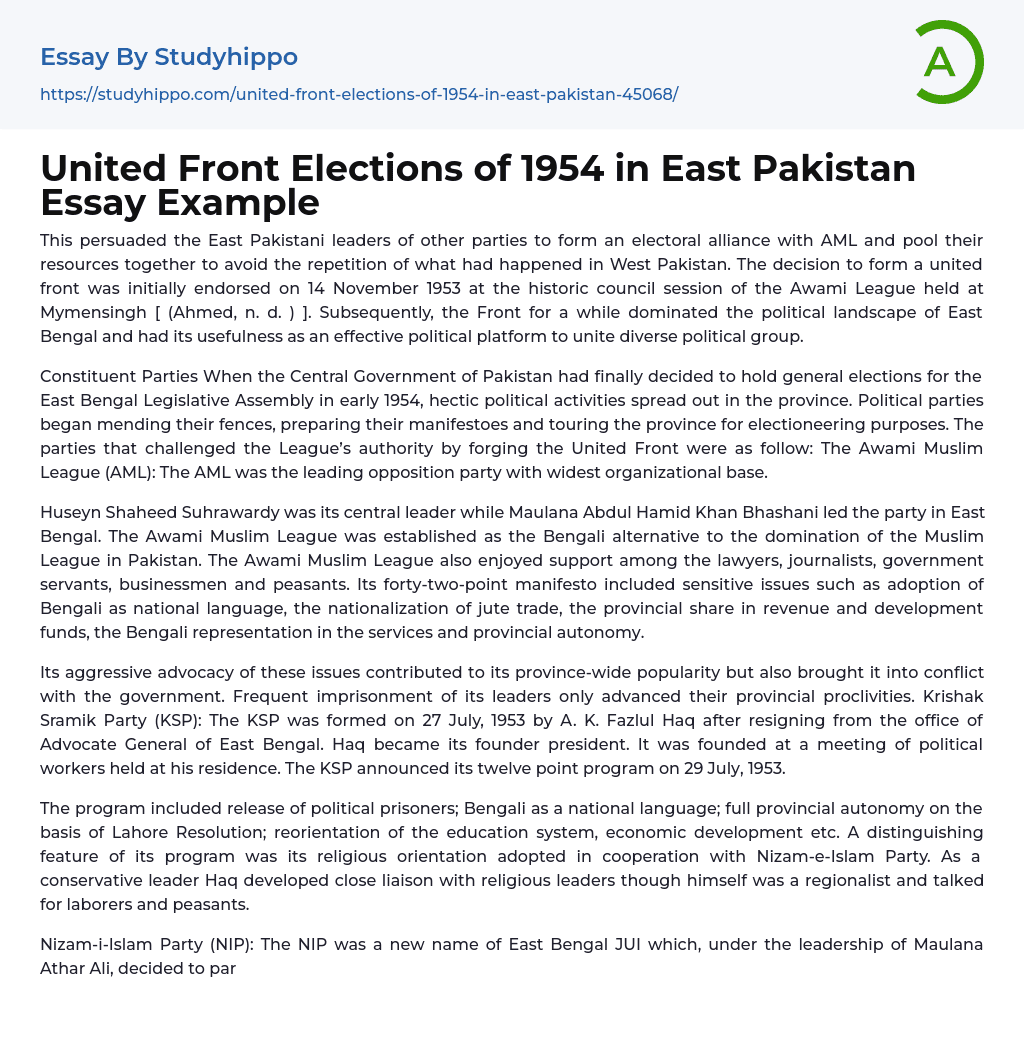

United Front Elections of 1954 in East Pakistan Essay Example
This persuaded the East Pakistani leaders of other parties to form an electoral alliance with AML and pool their resources together to avoid the repetition of what had happened in West Pakistan. The decision to form a united front was initially endorsed on 14 November 1953 at the historic council session of the Awami League held at Mymensingh [ (Ahmed, n. d. ) ]. Subsequently, the Front for a while dominated the political landscape of East Bengal and had its usefulness as an effective political platform to unite diverse political group.
Constituent Parties When the Central Government of Pakistan had finally decided to hold general elections for the East Bengal Legislative Assembly in early 1954, hectic political activities spread out in the province. Political parties began mending their fences, preparing their manifestoes and touring the province for electioneering purposes. The parties that chal
...lenged the League’s authority by forging the United Front were as follow: The Awami Muslim League (AML): The AML was the leading opposition party with widest organizational base.
Huseyn Shaheed Suhrawardy was its central leader while Maulana Abdul Hamid Khan Bhashani led the party in East Bengal. The Awami Muslim League was established as the Bengali alternative to the domination of the Muslim League in Pakistan. The Awami Muslim League also enjoyed support among the lawyers, journalists, government servants, businessmen and peasants. Its forty-two-point manifesto included sensitive issues such as adoption of Bengali as national language, the nationalization of jute trade, the provincial share in revenue and development funds, the Bengali representation in the services and provincial autonomy.
Its aggressive advocacy of these issues contributed to its province-wide popularity but also brought
it into conflict with the government. Frequent imprisonment of its leaders only advanced their provincial proclivities. Krishak Sramik Party (KSP): The KSP was formed on 27 July, 1953 by A. K. Fazlul Haq after resigning from the office of Advocate General of East Bengal. Haq became its founder president. It was founded at a meeting of political workers held at his residence. The KSP announced its twelve point program on 29 July, 1953.
The program included release of political prisoners; Bengali as a national language; full provincial autonomy on the basis of Lahore Resolution; reorientation of the education system, economic development etc. A distinguishing feature of its program was its religious orientation adopted in cooperation with Nizam-e-Islam Party. As a conservative leader Haq developed close liaison with religious leaders though himself was a regionalist and talked for laborers and peasants.
Nizam-i-Islam Party (NIP): The NIP was a new name of East Bengal JUI which, under the leadership of Maulana Athar Ali, decided to participate in politics directly. Its primary aim was to struggle for an Islamic order in Pakistan. The dismissal of the Nazim-ud-Din ministry (April 1953) and the fear of an un-Islamic constitution being imposed, as well as the mounting opposition to the Muslim League, induced it to function as a political party, independent of Muslim League, and to contest the elections as such.
Its main aim was to exert influence on constitution making process that would lead to the establishment of an Islamic order based on Quranic principles; but in other matters, like the language issue and provincial autonomy, it followed the lead given by the opposition parties. Ganatantri Dal (GD): The non-communal
left oriented the GD’s foundation was laid at a convention on 19 January, 1953, attended by about one thousand political workers. Mehmud Ali was its moving spirit. He was supported by Haji Muhammad Danish, a legendary peasant leader.



